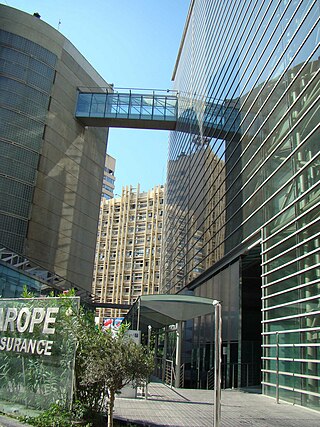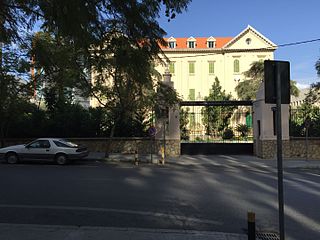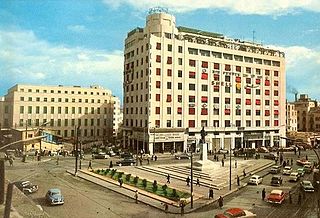
Achrafieh is an upper-class area in eastern Beirut, Lebanon. In strictly administrative terms, the name refers to a sector (secteur) centred on Sassine Square, the highest point in the city, as well as a broader quarter (quartier). In popular parlance, however, Achrafieh refers to the whole hill that rises above Gemmayze in the north and extends to Badaro in the south, and includes the Rmeil quarter.

The Lebanese Forces is a Lebanese Christian-based political party and former militia during the Lebanese Civil War. It currently holds 19 of the 128 seats in Lebanon's parliament, being the largest party of the country.

Martyrs' Square, historically known as "Al Burj" or "Place des Cannons", is the historical central public square of Beirut, Lebanon.

The Beirut Central District is the historical and geographical core of Beirut, the capital of Lebanon. Also called downtown Beirut, it has been described as the “vibrant financial, commercial, and administrative hub of the country.” It is thousands of years old, with a traditional focus of business, finance, culture, and leisure.
Joseph Philippe Karam (1923–1976) was a Lebanese architect. He was a leading figure of modern architecture in Lebanon during the country's golden era, 1945 to 1975. Karam founded his practice the Atelier d'Architecture Joseph Philippe Karam in the late 1940s.

The Corniche Beirut is a seaside promenade in the Central District of Beirut, Lebanon. Lined with palm trees, the waterfront esplanade has views of the Mediterranean and the summits of Mount Lebanon to the east. Corniche Beirut has its foundation in the Avenue des Français, which was built during the period of the Mandate for Syria and the Lebanon along the seafront that extended from the old town.

Rue Verdun, or Verdun Street, is an upscale commercial and residential street in Beirut, Lebanon. The street was named in honor of the Battle of Verdun during World War I. It is officially named Rachid Karami Street, after Lebanon's late Prime Minister who was assassinated during the Lebanese Civil War.

Platinum Tower is a highrise residential building in Beirut, Lebanon. It occupies a large plot on the Zaitunay Bay Marina, at Saint George Bay in the Beirut Central District.

The InterContinental Phoenicia Beirut is a historic 5-star luxury hotel situated in the Minet El Hosn neighborhood of Beirut, Lebanon. It is located on Rue Fakhreddine near the Corniche Beirut promenade and walking-distance from Beirut Central District, and a few kilometers from Beirut Rafic Hariri International Airport.
Jal El Dib or Jal Ed Dib is a Lebanese city in the kaza of Matn in the Mount Lebanon Governorate11 kilometers north of the capital city of Beirut.

Zahlé is a city in eastern Lebanon, and the capital and largest city of Beqaa Governorate, Lebanon. With around 150,000 inhabitants, it is the third-largest city in Lebanon after Beirut and Tripoli and the fourth-largest taking the whole urban area.

The Museum and Urban Cultural Center of Beirut or colloquially; Bayt Beirut/Barakat is a venue serving as a war memorial museum and artwork showcasing center dedicated to portraying the history of Beirut, with a particular focus on the Lebanese Civil War from artistic point of views. Housed in the restored Barakat building, also known as the "Yellow House," this historic landmark was designed by Youssef Aftimus.

Badaro is a residential neighborhood and business hub in the heart of Beirut, Lebanon. The neighborhood is roughly bounded by the Pierre Gemayel avenue on the north, the Hippodrome on the west, Sami el Solh avenue on the east, Beirut's pine forest on the southeast, and the Tayyouneh roundabout on the south. Badaro is the common name of Beirut's "Horsh" (park) administrative district, which also includes three parks: a75 acres (30 ha) pine forest known as Horsh Beirut, the Beirut Hippodrome and the Pine Residence, the French ambassador's residence.

The Battle of the Hotels was a subconflict within the 1975–77 phase of the Lebanese Civil War that occurred in the Minet-el-Hosn hotel district of downtown Beirut. This area was one of the first major battles of the war that began in April 1975. The battle was fought for the possession of a small hotel complex, the St. Charles City Center, adjacent to the gilded Corniche seafront area on the Mediterranean, in the north-western corner of the downtown district of Beirut, and it quickly spread to other areas of central Beirut. The often fierce battles that ensued were fought with heavy exchanges of rocket and artillery fire from the various hotel rooftops and rooms. Sniper fire was commonly utilized.
The following is a timeline of the history of the city of Beirut, Lebanon.

Beirut City Hall, also known as the Municipality of Beirut, is a landmark building built in downtown Beirut, Lebanon in 1924, and has become an architectural landmark in the downtown area of Beirut Central District. It features a yellow limestone facade and combines various architectural styles. The building is located on the intersection of Foch Street and Rue Weygand in the city center. The building is in the Venetian and Arabesque architectural styles, a mix that expresses the regional identity of the area.

The Hotel St. Georges is a historic resort hotel in Beirut, Lebanon, opened in 1934. It was constructed by a French investment group, the Société Des Grands Hotels Du Levant (SGHL), during the period of the French mandate. Parisian architect Auguste Perret came to Beirut to design the hotel with local architect Antun Tabet.

Riad Al Solh Square is a square in the heart of downtown Beirut, Lebanon.

The Egg, or the Dome, is an unfinished cinema building in Beirut, Lebanon. Its construction began in 1965 but was interrupted with the outbreak of the Lebanese Civil War in 1975 and the horse-shoe shaped dome that remains today is now a landmark in Beirut. Youssef El Zein, founder of GroupZein S.A.L, was assigned for the interior works. It was part of a commercial and residential project named "Beirut City Center", by architect Joseph Philippe Karam.
Le Commodore Hotel Beirut, also known as the Beirut Commodore Hotel, Hotel Commodore, or simply the Commodore is a five-star luxury hotel located on Rue Baalbek in the Hamra district of Beirut in Lebanon.
















